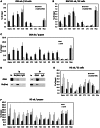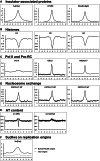Insulator protein Su(Hw) recruits SAGA and Brahma complexes and constitutes part of Origin Recognition Complex-binding sites in the Drosophila genome
- PMID: 23609538
- PMCID: PMC3675495
- DOI: 10.1093/nar/gkt297
Insulator protein Su(Hw) recruits SAGA and Brahma complexes and constitutes part of Origin Recognition Complex-binding sites in the Drosophila genome
Abstract
Despite increasing data on the properties of replication origins, molecular mechanisms underlying origin recognition complex (ORC) positioning in the genome are still poorly understood. The Su(Hw) protein accounts for the activity of best-studied Drosophila insulators. Here, we show that Su(Hw) recruits the histone acetyltransferase complex SAGA and chromatin remodeler Brahma to Su(Hw)-dependent insulators, which gives rise to regions with low nucleosome density and creates conditions for ORC binding. Depletion in Su(Hw) leads to a dramatic drop in the levels of SAGA, Brahma and ORC subunits and a significant increase in nucleosome density on Su(Hw)-dependent insulators, whereas artificial Su(Hw) recruitment itself is sufficient for subsequent SAGA, Brahma and ORC binding. In contrast to the majority of replication origins that associate with promoters of active genes, Su(Hw)-binding sites constitute a small proportion (6%) of ORC-binding sites that are localized preferentially in transcriptionally inactive chromatin regions termed BLACK and BLUE chromatin. We suggest that the key determinants of ORC positioning in the genome are DNA-binding proteins that constitute different DNA regulatory elements, including insulators, promoters and enhancers. Su(Hw) is the first example of such a protein.
Figures






Similar articles
-
[Ability of Su(Hw) to create a platform for ORC binding does not depend on the type of surrounding chromatin].Tsitologiia. 2013;55(4):218-24. Tsitologiia. 2013. PMID: 23875451 Russian.
-
A Drosophila insulator interacting protein suppresses enhancer-blocking function and modulates replication timing.Gene. 2022 Apr 20;819:146208. doi: 10.1016/j.gene.2022.146208. Epub 2022 Jan 29. Gene. 2022. PMID: 35092858
-
Su(Hw) primes 66D and 7F Drosophila chorion genes loci for amplification through chromatin decondensation.Sci Rep. 2021 Aug 20;11(1):16963. doi: 10.1038/s41598-021-96488-0. Sci Rep. 2021. PMID: 34417521 Free PMC article.
-
Genetic and molecular analysis of the gypsy chromatin insulator of Drosophila.Proc Natl Acad Sci U S A. 1996 Sep 3;93(18):9378-83. doi: 10.1073/pnas.93.18.9378. Proc Natl Acad Sci U S A. 1996. PMID: 8790337 Free PMC article. Review.
-
Mechanisms of Interaction between Enhancers and Promoters in Three Drosophila Model Systems.Int J Mol Sci. 2023 Feb 2;24(3):2855. doi: 10.3390/ijms24032855. Int J Mol Sci. 2023. PMID: 36769179 Free PMC article. Review.
Cited by
-
Study of the Ability of the gypsy Insulator to Stabilize Amplification of the chorion Replication Origin of Drosophila melanogaster.Dokl Biochem Biophys. 2018 May;480(1):166-168. doi: 10.1134/S1607672918030110. Epub 2018 Jul 14. Dokl Biochem Biophys. 2018. PMID: 30008102
-
Proximity-dependent biotin labelling reveals CP190 as an EcR/Usp molecular partner.Sci Rep. 2020 Mar 16;10(1):4793. doi: 10.1038/s41598-020-61514-0. Sci Rep. 2020. PMID: 32179799 Free PMC article.
-
Temporal association of ORCA/LRWD1 to late-firing origins during G1 dictates heterochromatin replication and organization.Nucleic Acids Res. 2017 Mar 17;45(5):2490-2502. doi: 10.1093/nar/gkw1211. Nucleic Acids Res. 2017. PMID: 27924004 Free PMC article.
-
The Functions and Mechanisms of Action of Insulators in the Genomes of Higher Eukaryotes.Acta Naturae. 2020 Oct-Dec;12(4):15-33. doi: 10.32607/actanaturae.11144. Acta Naturae. 2020. PMID: 33456975 Free PMC article.
-
Chromatin Modifiers in Transcriptional Regulation: New Findings and Prospects.Acta Naturae. 2021 Jan-Mar;13(1):16-30. doi: 10.32607/actanaturae.11101. Acta Naturae. 2021. PMID: 33959384 Free PMC article.
References
-
- Gerasimova TI, Gdula DA, Gerasimov DV, Simonova O, Corces VG. A Drosophila protein that imparts directionality on a chromatin insulator is an enhancer of position-effect variegation. Cell. 1995;82:587–597. - PubMed
-
- Pai CY, Lei EP, Ghosh D, Corces VG. The centrosomal protein CP190 is a component of the gypsy chromatin insulator. Mol. Cell. 2004;16:737–748. - PubMed
-
- Kurshakova M, Maksimenko O, Golovnin A, Pulina M, Georgieva S, Georgiev P, Krasnov A. Evolutionarily conserved E(y)2/Sus1 protein is essential for the barrier activity of Su(Hw)-dependent insulators in Drosophila. Mol. Cell. 2007;27:332–338. - PubMed
Publication types
MeSH terms
Substances
LinkOut - more resources
Full Text Sources
Other Literature Sources
Molecular Biology Databases
Miscellaneous

